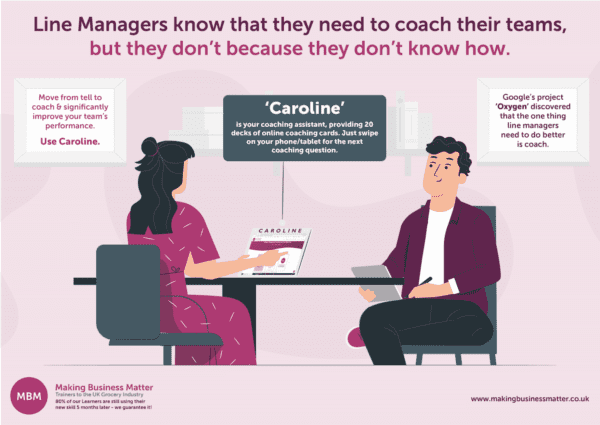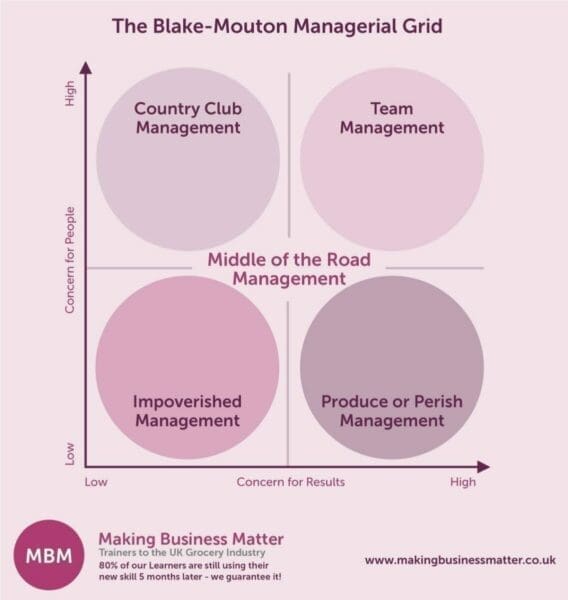“Let it Be – As Long As It‘s Working”
Laissez-faire leadership is an effective leadership style in businesses where people are achieving great things and can be relied on to perform. Laissez-faire leadership is the opposite of authoritative leadership and requires the least amount of managerial oversight.
There are some business operations where work must be supervised closely, and authoritative leadership is the only viable way. By contrast, laissez-faire leadership involves everyone committing to give their best and take responsibility for their part in the business’s success. The boss doesn’t walk away altogether, they’re in the background looking after the overall strategy, and getting involved when required.
So, this article explores what laissez-faire leadership is, illustrated by a real-life anecdote from a major FMCG company. For sure, some people see laissez-faire leadership as ‘taking a back seat.’ But it really means anything but, and can make a significant difference to the bottom line.
What Best Describes Laissez-Faire Leadership?

As a leader, first, you need to respect your employees’ talents and abilities. They report to you, but you give them autonomy to run their part of the business. You sign off on plans and agree on the goals and targets, giving support, guidance and coaching when needed. And then you trust them to get on with it.
Here’s the thing, you’re still there on the sidelines, checking in on work performance, giving feedback, making sure it’s all on track. And you step in and act as an authoritative leader if needs be.
What are the Characteristics of Laissez-Faire Leadership?
Laissez-faire leaders have characteristics that set them apart from other types of leaders. Here’s a suggested list:
- Delegate authority to capable experts.
- Develop people and maximise their leadership qualities.
- Praise accomplishments and reward success.
- Offer constructive criticism when necessary.
- Allow staff to solve problems and manage challenges.
- Know when to step in and lead during a crisis.
What are The Pros and Cons of Laissez-Faire Leadership?

First off, here are some pros:
- Allows leaders to prioritise other matters, like overall strategy.
- Encourages individual accountability.
- Gives individuals creative freedom.
- Prompts initiative and professional development.
- Creates a relaxed work environment.
And here are some possible cons:
- Doesn’t provide direction, oversight, or support.
- Can lead to a lack of accountability, and limited quality control.
- Risk of inconsistent performance and reduced productivity in team members who lack self-motivation.
- May compromise communication, and lead to hierarchical confusion: who’s in charge?
- Conflicting interpretations of roles and responsibilities.
- Slow decision-making in a crisis.
It’s best to talk about ‘likely’ and ‘possible,’ as every situation is different. What we can say for sure is, that laissez-faire leadership can achieve great things, but leaders and teams need to work together to watch out for things slipping and take the necessary action.
What Are Laissez-Faire Leadership Examples?
Companies or departments that benefit from laissez-faire leadership are often involved in product development or other innovations. Or, they’re engaged in highly creative businesses. Typical examples include:
- Advertising agencies
- PR agencies
- PR departments
- Marketing departments
- Management consultancies
- Product development and design
- Social media start-ups
- R&D departments
- Venture capital investment companies
- IT and specialist engineering businesses
The businesses we’ve just identified thrive under leaders with laissez-faire leadership styles. They hire experts and give them the freedom to make decisions, but they’re still leading and coaching them.
For example, the goal in the creative phase is perfecting products, services and systems through trial and error. But for campaigns to be carried out or for products to be manufactured, it needs discipline to make it happen. Exerting that discipline calls for authoritative leadership as necessary. You can return to a more laissez-faire style when the job’s done.

What Is Laissez-Faire Leadership Also Known As?
People also refer to laissez-faire leadership as delegate leadership because laissez-faire leaders are comfortable delegating tasks. They assign work and general direction but leave employees to decide the best way to fulfil their responsibilities, as long as it’s working.
What Is a Minimal Leadership Style?
According to the Harvard Business Review, minimalist leaders let their employees shine, put the good of the company above their own egos, and ultimately build stronger and more innovative businesses. So, you can call laissez-faire leaders minimalist, but if things start slipping, they exert their authority.
Laissez-Faire Leadership Versus Democratic Leadership: How Do They Measure Up?

In 1939, the German American psychologist Dr Kurt Lewin identified what we now know as Lewin’s three leadership styles:
- Authoritative
- Democratic
- Laissez-faire
So, what’s the difference between democratic and laissez-faire?
Democratic leaders, also known as participative leaders, encourage the free exchange of ideas among the team and rely on everyone contributing. Each team member shares the freedoms and responsibilities of leadership to an extent. Decisions may not be made quickly, especially in a crisis, and people may not pull their weight. Changing working habits and decentralised teams make this style more difficult. It calls for spontaneous, open, and candid communication, which can be challenging with remote working and virtual teams.
According to Dr Lewin, laissez-faire leaders exhibit 4 common behaviours:
- Complete freedom for group or individual decisions, without any leader participation.
- The leader supplies various materials and makes it clear they will give information when asked but take no other part in work discussions.
- Complete non-participation by the leader
- Infrequent comments on individuals’ activities unless questioned, and no attempt to participate or interfere with the course of events.
Lewin’s analysis makes laissez-faire leaders sound passive, but the reality is, successful ones are anything but.

>> Caroline Leadership Coaching Deck <<
Laissez-Faire Leadership in Management
Laissez-faire leaders have the vision and identify goals. After that, it makes sense to let managers and their teams get on with it. In the laissez-faire scenario, groups or individuals aren’t empowered to make far-reaching strategy decisions. Leadership sets out and signs off the vision, mission, and team plan. As the plan’s implemented, they’re kept in the picture, but only step in when they need to.
It’s also important to remember the difference between ‘management’ and ‘leadership.’ They’re often are used interchangeably but have distinct functions. Leadership sits on top of the business and produces change and movement. Management is answerable to leadership, and its central role is to provide order and consistency. Laissez-faire leaders put faith in the individual, and trust people to remain self-motivated, on-task, and personally accountable. Employees are left to decide the best way to fulfil their responsibilities day-to-day.
Most businesses don’t lack ideas, talent, or resources. The trouble is, under old-style authoritative leadership, they lack a conducive culture. Businesses need this so collaboration, creativity and agility can thrive. Laissez-faire leadership is the answer, because it relies, not on individual leaders’ authority, but on building collective leadership.
What Are The Characteristics of Laissez-Faire Leadership in Sport?
Sport has a huge influence on our popular culture, hence how we think about work, so it’s worth mentioning. In sports, a laissez-faire leader makes few decisions and gives their players the freedom to use their abilities independently. In business, a laissez-faire leader lets the players give their best but still play an active role, as we’ve been saying.
What Does Laissez-Faire Leadership Look Like in Real Life?
A global FMCG company recently transferred a senior manager to head a division of its UK operation. He was tasked with increasing its performance. The newcomer heard the sister division was flourishing. The senior managers and their teams were doing well, and the leadership trusted them to get on with it.
So the newcomer went to visit the company’s innovation centre, eager to find out more. This man had a successful track record of turning businesses around and restoring productivity and profitability. He had an authoritative leadership style and fancied himself as a troubleshooter. Speaking to the senior team, he made it clear that he thought they were too laid back for his liking. He didn’t grasp that he was seeing effective laissez-faire leadership in action.
Are You an Instrumental or an Expressive Leader?

Here’s something else for you to consider when thinking about laissez-faire leadership.
Since Dr Lewin’s time, sociologists have come to distinguish two types of leaders – instrumental, and expressive. An instrumental leader’s focus is to achieve goals and establish group tasks. They maintain productivity and get the job done, but in the process can alienate group members. An expressive leader focuses on building relationships between team members. People working for expressive leaders feel comfortable asking for guidance, support and coaching.
The Pandemic Has Made Companies Think Afresh about Laissez-faire Leadership
There’s a leadership style people also talk about called transformational leadership
It’s relatively new in management thinking, but it’s an important element in successfully managing change. Since COVID, a major challenge for businesses has been how to create strong working cultures for remote and hybrid teams. Wherever they’re located, competent people like the team in our anecdote earlier work better and feel more fulfilled with laissez-faire leadership, rather than have the boss constantly checking in. But they also need to be supported, nurtured and developed as people. This is an important part of the employee experience, and coaching plays a key role.
Laissez-Faire Leaders Need to Know the Importance of Emotional Intelligence
A laissez-faire leader needs to appreciate the importance of self-awareness and empathy in leading people to achieve goals and treating them as human beings with emotions. This is the true meaning of the phrase ‘human resources.’
This brings us to another important idea, emotional intelligence. In Daniel Goleman and colleagues Annie McKee and Richard Boyatzis’s 2002 book, ‘Primal Leadership: Realizing the power of emotional intelligence,’ they assessed the impacts of nearly 4,000 executives on their corporate climate and bottom line, and identified six leadership styles that motivated people and moved businesses forward. This highlighted six emotional leadership styles suited to specific situations:
- Coaching
- Affiliative
- Authoritative
- Democratic
- Pacesetting
- Visionary
What’s The Best Approach?
Well, the best approach is flexibility! Goleman and colleagues concluded the best leaders don’t know just one leadership style. They’re skilled at several and flex with the circumstances. Just like laissez-faire leaders do.
We mentioned the visionary aspect of laissez-faire leaders in the last list. It’s about creating the vision of where the team is going, and how to get there. sharing it with them, then leaving them to get on with it, while remaining in the background focusing on strategic leadership.
Laissez-faire leaders also need to be commanding or authoritative at times. A steady hand is necessary to maintain decisiveness and purpose. It’s essential for any kind of leadership. At the same time, leaders must engage with their people and support them. In this respect, laissez-faire leadership involves aspects of another important leadership style we’ve not mentioned so far, servant leadership.
Judging how to do all this effectively requires active listening and emotional intelligence. It also calls for self-care and self-management, protecting their own well-being. Because it isn’t easy, that’s for sure.
And Finally: Where Are You on the Grid?
As we’ve been saying, laissez-faire leadership requires leaders and managers to have faith in their team being capable, competent, committed and self-starters, while also keeping an eye on how they’re getting on. Here’s a tool to help you track how close you are to your team.

Robert Blake and Jane Mouton created the Blake Mouton grid in 1964. It weighs leaders’ and managers’ concerns for people, rated 1-9, against their concern for production. Here are five common profiles:
1.1 – Impoverished Management: This person scores low on both counts. They don’t have much regard for individual employees or their work.
9.1 – Task Management: This leader is more concerned with the work than the people doing it.
1.9 – Country Club: These people have a high focus on people, but little emphasis on production levels. They may be caring leaders, but work can fall behind.
5.5 – Middle of The Road: They consider their employees’ well-being, but their focus is always shifting between people and production.
9.9 – Team Management: This person pays attention to both the team AND production. Taking care of teams motivates them to produce great results.
It’s Your Call

We talked about Goleman, McKee, and Boyatzis’s book ‘Primal Leadership’ just now. In it, they proposed that a leader’s usual style creates about 70% of their business’s emotional climate. This in turn drives around 20%, or even 30%, of its profitability.
Companies devote huge resources to increasing their profitability by just 1%. The implications are truly awesome if leaders really do contribute 30 times that through their behaviour! Yes of course you’ll need to be authoritative at times. Even so, embracing laissez-faire leadership and applying it when practical is a great first step on the journey to making your business great.
There Are Lots of Leadership Styles You Can Adopt as Needed

The list of leadership styles has grown since Dr Kurt Lewin’s pioneering work. On this note, there are Lewin’s three styles we’ve mentioned:
- Authoritative
- Democratic
- Laissez-faire
The list now commonly quoted also includes:
- Pacesetting: Wanting to see results, you hustle your team.
- Coaching: Knowing the results you want, you help individual team members reach the goal.
- Affiliative: You put other people first and have lots of empathy. Nurturing your team comes naturally in tough times.
- Transformational: Inspiring people, pushing them outside their comfort zone, and ready to succeed in a changing environment.
People often refer to this longer list as the 7 leadership models.
Where Does Strategic Leadership Fit In?

People sometimes talk about strategic leadership as a specific leadership style. Like laissez-faire leaders, strategic leaders help formulate the plan, sign off on it and remain in the background. They exert their influence, rather than their authority, to achieve the desired outcome. By exercising leadership in this way, they keep everyone focused on the vision and the goals. They give them direction and purpose. We’ll come back to strategic leadership in a moment.
Try a Different Approach
Maybe We Shouldn’t Think of Leadership Being about Roles, but More about Mindsets and Behaviours.”
Gustavo Razzetti, the founder of the Fearless Culture transformation consultancy, believes most business problems are caused by a broken leadership model. Razzetti specifically means authoritative leadership. He sees leadership as more than an individual’s position. Instead, it’s a mindset and behaviour. Everyone in the business can – and, says Razzetti, must – lead, regardless of their role. Razzetti identifies 3 kinds of leadership:
- Positional leadership comes with your title and rank, rather than people’s respect for you or trust in you. It’s about power and hierarchy enforcing compliance. Razzetti goes so far as to describe authoritative leadership as ‘fearful leadership.’ In this context, he means such leaders are fearful of the loss of their power if their authority is challenged.
- Functional leadership is based on the function and role you play, and how you personally add value to the business.
- Personality leadership is based on developing organic relationships with colleagues. You inspire and influence others because they trust you. Personality leadership is based on influence and strong relationships.
Following Razzetti’s argument, businesses need to move away from focusing on positional leadership. If they look instead at functional and personality leadership as he defines them, then laissez-faire leadership comes into its own.
What’s the Best Approach?
An effective laissez-faire leader isn’t completely hands-off, as Kurt Lewin argued. They are there in the background thinking about as we’ve been maintaining. Their role includes knowing what to do and when in order to advance the vision and the strategy. It also means stepping in and dealing with day-to-day matters to keep things going. So, leadership frequently gets involved in equity, diversity, and inclusivity matters, including supporting LGBTQ people coming out in the workplace.
Updated on: January 18, 2024




